Last week when Readmill launched to the public I jumped in with both feet, blogging about its general greatness and on some novel uses for it. Inevitably, after I started using the Readmill iPad eBook reader more, and thus generating more highlights, I went looking for my highlights, and others’ highlights, in RSS form. When I didn’t find them, I tweeted and Readmill replied:

Fortunately, despite the absence of RSS, Readmill does have a public API, making it possible to roll ones own RSS. Which turned out to be a relatively easy task in Yahoo Pipes: just slurp in the publicly exposed XML of everyone’s highlights, loop through each item to look up the title of the book in question, and emit as RSS: ta-da, you’ve got an RSS feed of everyone’s Readmill highlights, something that looks like this in Google Reader:
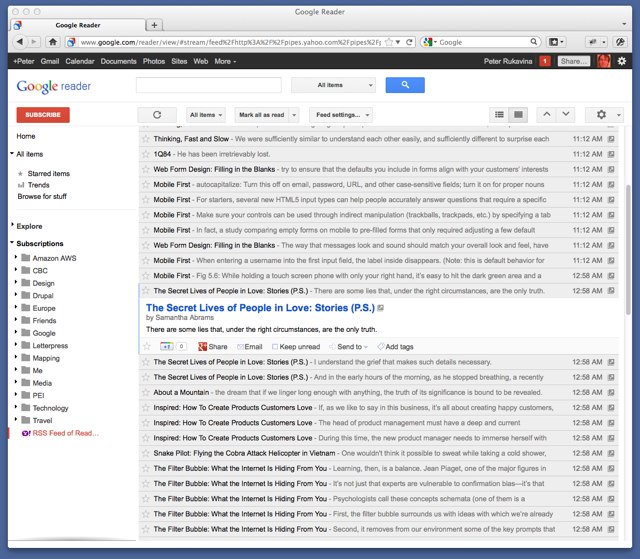
You’d think that an RSS feed of everyone’s highlights wouldn’t be all that useful and, indeed, when I encounter highlights in German or Chinese it’s not; but, on balance, I’ve been finding this RSS feed is a goldmine of interestingness. It is, after all, a constant stream of things that other people find interesting enough to highlight, and thus, in essence, a stream of what’s good about what’s good.
And it’s more than just passing-interest: yesterday I bought a book — The Hollywood Economist — based on the interesting highlights I’d seen stream by in my RSS from Readmill community manager Aaron Kelly.
Note that none of this would have been possibly without the open systems and associated bits of flue underlying it all: Readmill’s API which exposes XML; Yahoo Pipes which reads XML and transforms it into RSS; Google Reader which consumes RSS; Melville House, the publisher, which had the courage to release a book unencumbered by DRM (which both enabled Aaron to read-and-highlight it, and me to buy it).
In the ABC News Iowa Republican Presidential debate held last week candidate Mitt Romney was asked a question by moderator George Stephanopoulos:
Governor Romney, Speaker Gingrich crystallized his argument a couple of weeks ago. He said, and I quote, “I’m a lot more conservative than Mitt Romney, and a lot more electable than anyone else.”
Romney replied, in part (emphasis mine):
But really, this is more about— about us talking about what we believe. And w— and whether we can lead the country at a time when— when we need to restore the kind of values that make America the greatest nation on Earth.
We have in Washington a president who believes in a fundamental transformation of America into an entitlement society. Where the government takes for some from some and gives to everybody else. And the only people that do real well in that setting are the people in the government. This nation was founded on the principle of being a merit society, where education, hard work, risk taking, have lifted certain individual, and they have helped lift— lift the entire nation.
All credit to Romney for the clarity of this explanation; I like it when candidates talk in broad terms about their worldview rather than about the minutiae of their personal lives or their narrower interest-based policies.
Constrast Romney’s philosophy with that put forward by President Obama in an interview on Sunday with 60 Minutes:
If we make sure that everybody’s doing their fair share, to pay for things like infrastructure improvements in basic science and research and advanced manufacturing and innovation, we ask those who’ve benefited the most over the last three decades, we ask them to do a little bit more. And if we’ve got tough rules of the road — like the financial reform package that we passed into law last year — there’s no reason why over the next five, ten years, we cannot reposition ourselves so that every single American, no matter what they look like, no matter where they come from, they can succeed. And that’s my goal as President. That’s what I think about every day. And that’s what led me to run for president in the first place.
While on the surface they are saying the same thing — “work hard and you can succeed” — they approach this issue from completely different poles: Romney is saying, in essence, “there will always be a class of successful individuals who will, through their activities, provide a climate where others might thrive” whereas the President’s position is more akin to “together we can create a climate where everyone can thrive.” It’s a subtle but extremely important — and polarizing — difference in philosophy.
I wish that the American Presidential campaign could be about this, about competing political philosophies. And not about how many marriages someone has had, or what labels we should apply to various candidates, or whether a given candidate changed their mind about something.
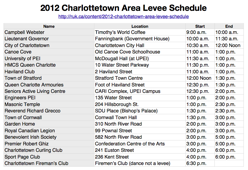 Here’s is the 2012 levee schedule for January 1, 2012 for Charlottetown, Prince Edward Island and area. If you’re new to all of this and want to give it a try, read How to Levee.
Here’s is the 2012 levee schedule for January 1, 2012 for Charlottetown, Prince Edward Island and area. If you’re new to all of this and want to give it a try, read How to Levee.
Print out this handy PDF file and carry it in your pocket to guide you through the day, and spread the word on Facebook and Twitter.
| THE LEVEE OF… | HELD AT… | STARTS | ENDS |
|---|---|---|---|
| Campbell Webster | Timothy’s World Coffee | 9:00 a.m. | 10:00 a.m. |
| Lieutenant Governor | Fanningbank (Government House) | 10:00 a.m. | 11:30 a.m. |
| City of Charlottetown | Charlottetown City Hall | 10:30 a.m. | 12:00 Noon |
| Polar Bear Swim | Foot of Pownal Street | 10:30 a.m. | 11:00 a.m. |
| Canoe Cove | Old Canoe Cove Schoolhouse | 11:00 a.m. | 1:00 p.m. |
| University of PEI | McDougall Hall (at UPEI) | 11:00 a.m. | 1:00 p.m. |
| HMCS Queen Charlotte | 10 Water Street Parkway | 11:30 p.m. | 1:00 p.m. |
| Haviland Club | 2 Haviland Street | 11:00 a.m. | 1:00 p.m. |
| Town of Stratford | Stratford Town Centre | 12:00 Noon | 1:30 p.m. |
| Prince Edward Island Regiment | Queen Charlotte Armoury, Haviland St. | 12:30 p.m. | 1:30 p.m. |
| Seniors Active Living Centre | CARI Complex, UPEI Campus | 12:30 p.m. | 2:00 p.m. |
| Engineers PEI | 135 Water Street | 1:00 p.m. | 2:00 p.m. |
| Masonic Temple | 204 Hillsborough St. | 1:00 p.m. | 2:30 p.m. |
| Reverend Richard Grecco | SDU Place (Bishop’s Palace) | 1:30 p.m. | 2:30 p.m. |
| Town of Cornwall | Cornwall Town Hall | 1:30 p.m. | 3:00 p.m. |
| Garden Home | 310 North River Road | 2:00 p.m. | 3:00 p.m. |
| Royal Canadian Legion | 99 Pownal Street | 2:00 p.m. | 3:00 p.m. |
| Benevolent Irish Society | 582 North River Road | 3:00 p.m. | 5:00 p.m. |
| Premier Robert Ghiz | Confederation Centre of the Arts | 3:00 p.m. | 5:00 p.m. |
| Charlottetown Curling Club | 241 Euston Street | 4:00 p.m. | 6:00 p.m. |
| Sport Page Club | 236 Kent Street | 4:00 p.m. | 6:00 p.m. |
| Charlottetown Fireman’s Club | Firemen’s Club (dance not a levee) | 6:30 p.m. |
All levee times have been confirmed by telephone or email contact with organizers, or with information from published sources.
Other Formats
- PDF (print and carry in your pocket!)
- iCal (load into your iCal on a Mac to sync with your iPod Touch or iPhone)
- XML (load into any RSS feed reader)
- Google Calendar
- CSV (import into a spreadsheet or roll-your-own app)
Updates
- Removed Handibear Hills, which is not having a levee this year. But they are having “open barn week” between Boxing Day and New Years Eve.
- Added Engineers PEI, a new levee this year.
- Changed start time of UPEI levee to 11:30 a.m.
- Changed time for Charlottetown Fireman’s Club to 6:30 p.m. and noted that it’s a dance and not a levee; in their words, “everyone comes here after the levees.”
- Changed time of Masonic Temple levee to 1:00 p.m.
- Confirmed times for HMCS Queen Charlotte and Haviland Club.
- Added time for Polar Bear Swim (not technically a levee, but…).
- Confirmed times for Benevolent Irish Society and Prince Edward Regiment (all times now confirmed).
Our friend Beth Cudmore died last week.
Our lives overlapped with Beth’s in innumerable ways over the last 20 years: I used to shop at Henderson & Cudmore, the Charlottetown haberdasher run by the family; I worked with Beth’s son Chris at the Anne of Green Gables Store; I counted Beth’s late husband Brian as a good friend; I came to know Beth’s daughter Cynthia, first here on PEI and later through her Panamanian operation and her daughter Carolyn, with whom I shared an excellent travel agent; I helped Beth get her computer working when it had problems; and, by coincidence, I am friends with many of the people who called Beth a landlord over the years.
Perhaps more than anything, however, I got to know Beth around the dinner table at our mutual friend Catherine Hennessey’s house, and through the dinners and Christmas and birthday parties we shared there I came to know her as an independent, funny, caring, curious person.
The last time I saw Beth was earlier this fall — it seems like only yesterday — around that same dinner table. We talked about our Volkswagens, about her kids and grandkids and about Oliver and shared a meal with friends and family.
During Oliver’s first summer back a decade ago in the summer of 2001 my friends Sophie and Oliver (Oliver’s namesake) visited from the USA and we used the occasion to hold an “Oliver Oliver” party at 100 Prince Street. Beth and Brian both came, and I snapped this photo of the two of them:
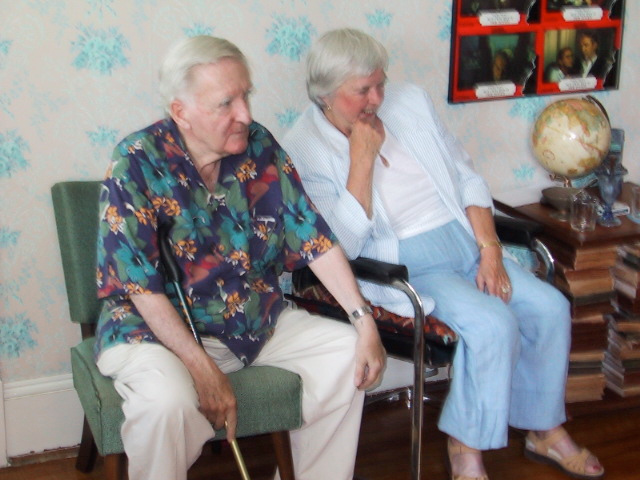
We’ll miss Beth around that supper table; our condolences go out to her family.
It’s beginning to look a lot like Christmas, so I decided that it was time to dust off the Mail Me Something list and set up something for the holidays. I set some type tonight, and I hope to start printing, on the new press, tomorrow. Two colours (red and black), on white index cards. Text by Dickens. Here’s where I’m at right now:
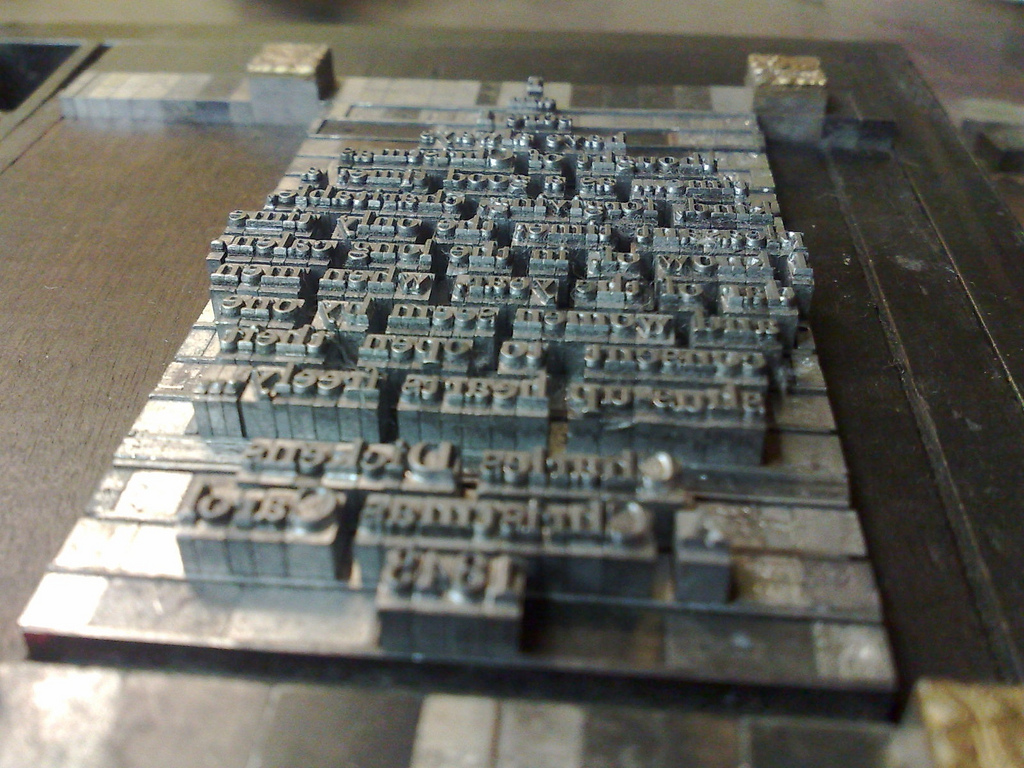
By the way, if you’re a subscriber and you’ve moved (say, from PEI to Toronto, or Nunavut to Toronto, or something like that), please get in touch with your new address so I send this to the right place.
I am old.
As far as I can remember, I didn’t used to be old. Back in the late 1980s in Ontario I remember being young. I had a good group of friends, mostly around my own age. We played charades and drank beer and made tofu casseroles and talked about Saul Alinsky and swam at the swimming hole. Life was good.
Then everything came crashing down: marriages ended, people moved away, feuds started, and Catherine and I skipped town and escaped to remotest Prince Edward Island.
My social life on the Island since, such as it is has been, has consisted mostly of spending time with people over 60 or under 30; people in both groups are distant enough from my own age so as to allow me to exist in a sort of age-free neutral zone. Because I’m neither a 25 year old rocker nor a 75 year old hipster, I’ve been able to coast along inside a delusion that I’m neither old nor young.
This all came crashing down yesterday when Catherine and I, in what appeared to me to be some sort of social destratification accident, were invited to the edge of Brighton for a house party attended mostly by our peers: couple in our 40s with children.
In the run of my day-to-day life I have some evidence that people like this exist in Charlottetown — I see them in them in the shops, and follow them on Twitter — but to be suddenly confronted with my own demographic, en masse, after a 20 year drought, was bracing to say the least.
This is how old I am?
I don’t mind being old: it’s been my goal, since I was a child, to get older.
And it wasn’t like there was anything wrong with my 40-year-old peers (although their taste in music could use some work). As much as it’s possible for me to have a good time drowning inside any group of people, I had an entirely pleasant time.
No, the shock to my system was more about the sudden jump out of hyperspace: when I last checked in with my peer group we were young and wild and free, and now, by all appearances, we have children, we talk about velorailing in France, and we’re in charge of the universe.
This isn’t a novel revelation, of course: there’s an entire genre of sitcoms based on this plot device (although usually they involve divorce and star Hank Azaria).
But is is a kick in the head for me; the Whole Earth Catalog told us that “we are as gods and might as well get good at it” and suddenly realizing that I’m an adult makes me realize that it might be time to pay closer attention to that notion and start to get some stuff done.
My social hermitage being what it is, it’s likely that the next time I check in with the peers we’ll all be in our mid-60s, and another 20 years will have flown by. So it’s best that I leverage this sudden realization of my oldness and run with it for all it’s worth.
Don’t let us get sick
Don’t let us get old
Don’t let us get stupid, all right?
Just make us be brave
And make us play nice
And let us be together tonight
— Warren Zevon, “Don’t Let Us Get Sick”
I was interested to learn this morning from CBC News that the combined assets of the O’Leary and Evangeline credit unions, which voted last night to merge, will be $100 million.
This got me wondering what the combined assets of all Prince Edward Island credit unions is, and how this compares to the provincial debt.
With some assistance from the communications office of Atlantic Credit Unions here in Charlottetown I was able to find the first figure: there are $784 million in assets under management in PEI credit unions (that’s a pretty-amazing $5600 for every person on the Island).
A quick call to a helpful official in the PEI Dept. of Finance guided me to the latest Public Accounts where I learned the second: depending on how you slice it, this is either $1,695 million or $865 million, depending on whether you express the figure as “what we owe” (the first) or “what we owe minus what we own.”
Interesting.
Did you know that recent versions of Apple’s Pages word processing application can export to the ePub format? Presumably this was a step taken by Apple to enhance the utility of its own iBooks application, but ePub is ePub, and Readmill can read it too.
Last week I had a PEI Home and School Federation meeting and in advance of the meeting I receive a Microsoft Word copy of the Federation’s Policy Manual. Because I wanted to review the manual and highlight and share relevant passages with my fellow board members, I loaded the Word file into Pages, and exported it as an ePub, then emailed myself the result and opened the email on my iPad and opened the ePub in Readmill’s iPad reading app:
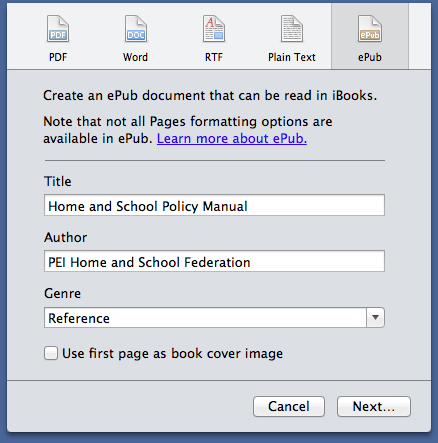
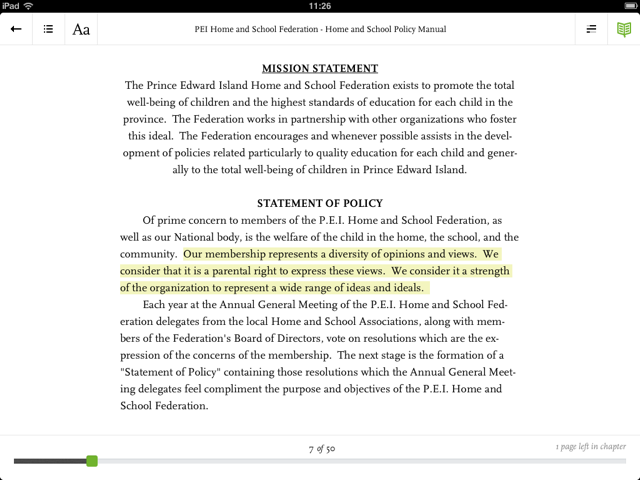
I then used the Readmill reader on the iPad to read the manual and highlight passages; as I did this, the highlights accumulated on the Readmill web page for the manual, from which I could share them, comment on them, and otherwise have the highlights take on a digital life of their own. Like this, for example:
Highlighted by Peter Rukavina in Home and School Policy Manual
This is an example of Readmill’s great power and competitive advantage: Kindle, Kobo, Nook and their brethren, while useful in their own way, exist as platforms with the ultimate goal of getting you to buy more books. They are the razors for which you are to buy an endless stream of razor blades. Readmill, because it’s not looking to sell you books, is not similarly shackled, and so can optimize for things like openness and sharing and reuse, freeing words from the boundaries of their books and allowing them to take on a life of their own.
Contrast this, for example, to the Kindle approach to the same functionality: I read the book Ah-Choo!: The Uncommon Life of Your Common Cold in the Kindle app on my iPad and made a lot of highlights. I can login to kindle.amazon.com and see and manage all my highlights for that book, but the individual highlights don’t have their own URLs, and there’s no way for me to share my highlights with others — when I logout of Amazon.com the page I was looking for my highlights devolves into a generic summary page with a selection of popular, uncredited highlights. That’s what digital reading looks like without optimizing for sharing.
Yes, I’m sounding like a cheerleader for Readmill, but I see great potential in the Readmill ecosystem, and it’s already proving to be a useful part of my day-to-day workflow.
This summer in Berlin I had the pleasure of meeting the founders of Readmill. I’d been a beta-user of the service for a few months and, truth be told, didn’t know they were a Berlin company until Eric Wahlforss suggested I pay them a visit (as it turns out they share office space with Amen, a company co-founded by my former Plazes colleague Felix Petersen; it’s a small world).
After many months stealthing around in an invite-only beta, Readmill took the covers off yesterday, and anyone can sign up now; if you’re interested in eBook-reading, and you have an iPad, I encourage you to do so, as Readmill is doing some really, really interesting things. Like this:
Highlighted by Peter Rukavina in The printers’ handbook of trade recipes, hints & suggestions relating to letterpress and lithographic printing, bookbinding stationery, engraving, etc. With many useful tables and an index
That’s a embedded version of this highlight I made in this book that I’ve been reading in the Readmill iPad eBook reader after grabbing the free ePub-formatted version of the book from Google Books.
For me the killer feature of Readmill is its highlight-management: here’s a web page listing all the highlights I made while reading that book. Every highlight has it’s own URL — here’s one, for example — meaning that highlights can be emailed, tweeted and otherwise shared. What’s more, all my highlights are also available via an API, meaning that I can search them, sort them, re-use them and tunnel them into other applications and services.
All of this adds up to Readmill being much more than an eBook reader — indeed the Readmill folks will admit that their iPad app is more of a platform catalyst than a “product” in its own right. No, Readmill is really a eBook data management platform: look under the hood and you find all the hooks and infrastructure you need to bake Readmill’s features into any eBook appliance or service. And that’s the real reason why Readmill is exciting.
Which is not to say that Readmill’s iPad eBook reader isn’t also a thing of beauty and elegance: it is, hands down, the best eBook reader for that platform, with just the right mix of simplicity and features to make eBook reading pleasureable and more-than-just-digital-paper. While it’s limited to reading books in the open ePub format (so it can’t read your DRM-locked Kindle and Nook books), that is, net-net, a positive and not a negative, for to be truly useful and practical eBook infrastructure can’t be shackled by the restrictions that DRM imposes (it might be less of a negative for me, I admit, given my interest in books from the 1800s about letterpress, books that are long out of copyright and plentiful in ePub form).
Readmill is the first platform to come along that’s made me excited about the potential of reading digitally: you can friend me up at http://readmill.com/ruk and we can go reading together.
When I first acquired my tiny Adana Eight Five letterpress last year I was a little obsessed with tuning up and cleaning the press to “perfect” condition before actually getting down to printing. Then I read a post on the excellent letterpress-focused BriarPress.org website that said, in essence, “stop fussing about and just start printing!” So I did.
It was a good idea: there’s no better way to get to know the ins and outs of a letterpress than using it for its intended purpose. It will never be perfect, and, in the end, it’s far more important to develop a personal relationship with the physics of the press than it is to make sure every washer is polished.
With this in mind, after the press sprang to life on the weekend I was eager to print something — anything — on the Golding Jobber No. 8 that’s now playing the older-brother role to the Adana. I decided that a 1947 CFCY radio coverage map loaned to me by Ian Scott and Daphne Large would be the perfect thing: it’s too big to fit on the Adana so I’ve never had a chance to print it. And it’s a pretty neat map. Here’s the result:
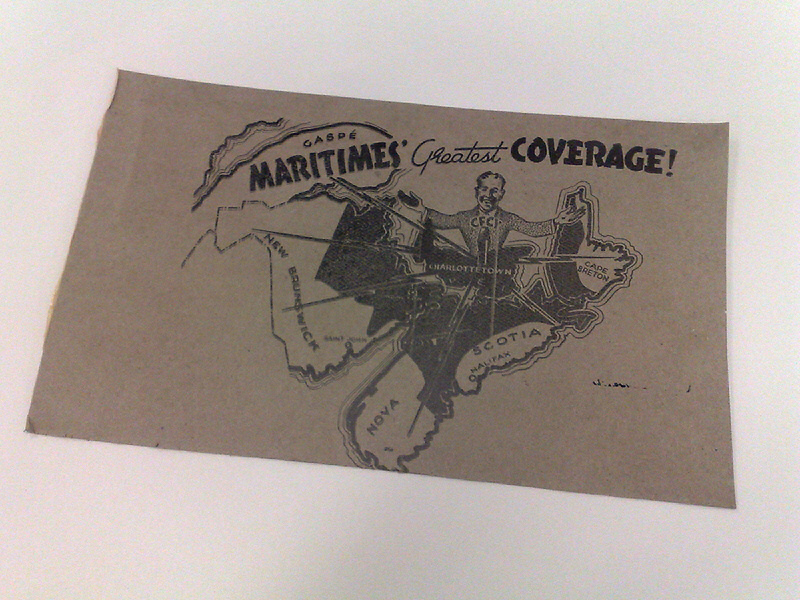
It’s by no means a perfect print: it’s printing on rough cardboard; I only used one of the three rollers, so the ink coverage is uneven (the white line through the announcer’s body and Eastern Kings is due to a nick in the roller); and I haven’t learned yet how to make the subtle makeready adjustments on this larger scale that even things out. But it’s still pretty neat.
Here’s a short time-lapse video I made with my iPad (using iMotion HD) that covers the 30 minutes from when I first arrived until the first print came off the press:


 I am
I am